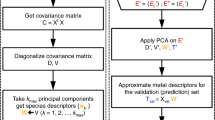Abstract
THE unique role that gold plays in society is to a large extent related to the fact that it is the most noble of all metals: it is the least reactive metal towards atoms or molecules at the interface with a gas or a liquid. The inertness of gold does not reflect a general inability to form chemical bonds, however—gold forms very stable alloys with many other metals. To understand the nobleness of gold, we have studied a simple surface reaction, the dissociation of H2 on the surface of gold and of three other metals (copper, nickel and platinum) that lie close to it in the periodic table. We present self-consistent density-functional calculations of the activation barriers and chemisorption energies which clearly illustrate that nobleness is related to two factors: the degree of filling of the antibonding states on adsorption, and the degree of orbital overlap with the adsorbate. These two factors, which determine both the strength of the adsorbate-metal interaction and the energy barrier for dissociation, operate together to the maxima] detriment of adsorbate binding and subsequent reactivity on gold.
This is a preview of subscription content, access via your institution
Access options
Subscribe to this journal
Receive 51 print issues and online access
$199.00 per year
only $3.90 per issue
Buy this article
- Purchase on Springer Link
- Instant access to full article PDF
Prices may be subject to local taxes which are calculated during checkout
Similar content being viewed by others
References
Hayden, B. E. & Lamont, C. L. A. Phys. Rev. Lett. 63, 1823–1825 (1989).
Hodgson, A., Moryl, J., Traversaro, P. & Zhao, H. Nature 356, 501–504 (1992).
Michelsen, H. A., Rettner, C. T. & Auerbach, D. J. Phys. Rev. Lett. 69, 2678–2681 (1992).
Michelsen, H. A., Rettner, C. T., Auerbach, D. J. & Zare, R. N. J. Chem. Phys. 98, 8294–8307 (1993).
Berger, H. F., Leisch, M., Winkler, A. & Rendulic, K. D. Chem. Phys. Lett. 175, 425–428 (1990).
Robota, H. J., Vielhaber, W., Lin, M. C., Segner, J. & Ertl, G. Surf. Sci. 155, 101–120 (1985).
Brown, J. K., Luntz, A. & Schultz, P. A. J. chem. Phys. 95, 3767–3774 (1991).
Jaffey, D. M. & Madix, R. J. Surf. Sci. 311, 159–171 (1994).
Hammer, B., Scheffler, M., Jacobsen, K. W. & Nørskov, J. K. Phys. Rev. Lett. 73, 1400–1403 (1994).
White, J. A., Bird, D. M., Payne, M. C. & Stich, I. Phys. Rev. Lett. 73, 1404–1407 (1994).
Gross, A., Hammer, B., Scheffler, M. & Brenig, W. Phys. Rev. Lett. 73, 3121–3124 (1994).
Feibelman, P. J. & Harris, J. Nature 372, 135–136 (1994).
Hammer, B. & Scheffler, M. Phys. Rev. Lett. 74, 3487–3490 (1995).
Lundqvist, B. I., Gunnarsson, O., Hjelmberg, H. & Nørskov, J. K. Surf. Sci. 89, 196–225 (1979).
Holloway, S., Lundqvist, B. I. & Nørskov, J. K. in Proc. int. Congr. on Catalysis 85–95 (Chemie, Berlin, 1984).
Nørskov, J. K. Rep. Prog. Phys. 53, 1253–1295 (1990).
Andersen, O. K., Jepsen, O. & Glötzel, D. Highlights of Condensed Matter Theory Vol. LXXXIX 59 (Corso Soc. Italiana di Fisica, Bologna, 1985).
Nørskov, J. K. J. chem. Phys. 90, 7461–7471 (1989).
Hammer, B. & Nørskov, J. K. Surf. Sci. (submitted).
Payne, M. C., Teter, M. P., Allan, D. C., Arias, T. A. & Joannopoulos, J. D. Rev. mod. Phys. 64, 1045–1097 (1992).
Perdew, J. P. et al. Phys. Rev. B46, 6671–6687 (1992).
Kittel, C. Introduction to Solid State Physics (Wiley, New York, 1968).
Author information
Authors and Affiliations
Rights and permissions
About this article
Cite this article
Hammer, B., Norskov, J. Why gold is the noblest of all the metals. Nature 376, 238–240 (1995). https://doi.org/10.1038/376238a0
Received:
Accepted:
Issue Date:
DOI: https://doi.org/10.1038/376238a0
This article is cited by
-
Ten-electron count rule for the binding of adsorbates on single-atom alloy catalysts
Nature Chemistry (2024)
-
Ultrasmall metal alloy nanozymes mimicking neutrophil enzymatic cascades for tumor catalytic therapy
Nature Communications (2024)
-
Engineering the Interface Between Au Nanoparticles and CoO-Ov to Enhance the Catalytic Performance of 5-Hydroxymethylfurfural (HMF) to 2,5-Dimethylfuran (DMF)
Chemical Research in Chinese Universities (2024)
-
Controlling of coordination state of RuxNy clusters for efficient oxygen reduction electrocatalysis
Nano Research (2024)
-
Enhanced Redox Electrocatalysis in High-Entropy Perovskite Fluorides by Tailoring d–p Hybridization
Nano-Micro Letters (2024)
Comments
By submitting a comment you agree to abide by our Terms and Community Guidelines. If you find something abusive or that does not comply with our terms or guidelines please flag it as inappropriate.



